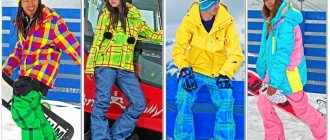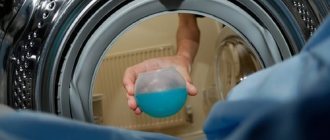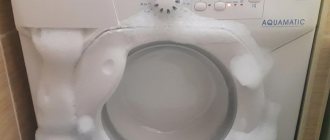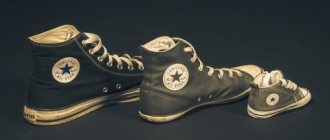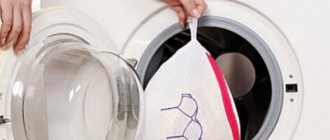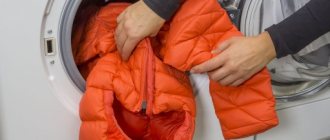Instructions for caring for clothes with a GORE-TEX® membrane: washing, drying, impregnation
There is a persistent myth that washing and caring for high-tech membrane materials require the use of special methods and special detergents.
This misconception is due to the fact that the thinnest membrane laminate itself is quite fragile and has millions of microscopic holes that can easily become clogged with ingredients contained in detergents.
However, the membrane film in the laminate structure is well protected and cannot be damaged during washing. And to maintain the characteristics of membrane clothing, you only need to follow some simple rules and follow the manufacturer’s instructions.
First of all, it is advisable to familiarize yourself with the recommendations themselves, which, as in ordinary clothing, are contained on a special label attached to the product. Next you need to perform the following procedures:
What is membrane fabric?
In essence, the membrane is an ordinary film. It can act as a covering or an oscillating surface. The material itself is created artificially using modern technologies.
It is intended for the production of a special type of clothing, which has a number of specific properties.
- During the garment manufacturing process, the membrane is usually placed on the inner surface of the fabric.
- In this case, the material used for sewing clothes can be anything. Here, not in it, but in the membrane itself.
- It performs several functions, such as protection from rain and ventilation of clothes.
Due to ventilation, excess water vapor is removed outside.
Due to its beneficial properties, membrane fabric is very popular among sportswear manufacturers.
What is Gore-Tex
The world-famous membrane owes its appearance to the Gor family of chemists. In 1959, a new material appeared in the chemical industry - Teflon. Bill and Genevieve Gore began to actively experiment with it, in search of new qualitative features of the material. Then they were joined by their son, Bob Gore (also a chemist by training).
Robert Gore
Interestingly, Gore-Tex came about as a result of Bob's mistaken experience. It was 1969. The material, which received properties such as waterproofness, elasticity and wear resistance, and at the same time was ultra-thin, became a breakthrough. In 1970, the technology for producing Gore-Tex was patented. The patent still belongs to the family.
In subsequent decades, WL Gore&Associates became the driving force behind the development of clothing and footwear for sports and outdoor activities. There are other membranes available today, but Gore-Tex remains the best known.
The Gore-Tex membrane is a porous material that is a thin film. Its pores are microscopic in size, so they do not allow a water molecule to pass through them. In clothing and footwear, Gore-Tex is a sandwich consisting of a lining fabric, a membrane itself and an external water-repellent material.
Types of membrane fabrics
Today you can find two types of membrane fabric.
Each of them has a number of features:
- Hydroporous membrane fabrics. This material has many small pores, which are many times smaller than water droplets. Thanks to this design, water cannot get inside; it remains on the surface. At the same time, these small pores perfectly generate steam, creating a comfortable microclimate under clothes. The only drawback is that hydroporous fabric is very sensitive to dirt. As a result, micro-holes quickly become clogged, and clothing loses its unique properties. It is also quite difficult to care for. However, today there is a special liquid detergent for membrane clothing on the market.
- Hydrophilic membrane fabric. This is foil that is applied to the material by heat treatment. Due to its chemical properties, foil does not allow water to pass through. However, it is susceptible to stretching and is not afraid of dirt, and is also characterized by the absence of small cells. How to care for her much easier? The most important thing to pay attention to is the temperature of the water. It should not exceed 30 degrees so as not to damage the fabric.
Product range
Nowadays, not only outerwear, but also shoes and gloves are made using the Gore-Tex membrane. To make it easier to choose the right product, products are divided into several categories. For shoes it is:
- Extended Comfort – the product is intended for warm weather;
- Performance Comfort – “all-season” shoes;
- Insulated Comfort - can be worn in cold weather.
For textiles the division is as follows:
- Gore-Tex – suitable for everyday wear;
- Performance – has greater vapor permeability;
- Pro (Gore-Tex) – with the highest vapor permeability and water resistance.
Thanks to the thoughtful choice of outer fabric and lining, products with Gore-Tex provide not only dryness, but also heat retention and are as comfortable to wear as possible. They are also valued for their strength and wear resistance.
The cost of such clothes or shoes increases by 25–40%, starting from $200–300. The cost of the membrane fabric itself is relatively low, however, for a brand that wants to use it in its products, it is required to purchase permission from the patent holder and certified equipment. The quality standards of WL Gore & Associates are met exclusively by reputable companies with a good reputation that have been present on the market for a long time, which means that you also have to pay extra for the label.
Detergents
It is best to give preference to special liquids and impregnations that correspond to the type of material from which our clothes are made. Stubborn stains must be removed before the main wash.
Undiluted TechWash® is ideal for this purpose. It should be applied to the area to be cleaned with a thin nylon brush or sponge.
Washing in a washing machine
Before washing, thoroughly clean the detergent dispenser in your washing machine. There should be no residues of other detergents in it.
- Place the clothes in the washing machine chamber (we wash no more than 2 items at a time).
- Depending on the water hardness, use the appropriate amount of detergent.
- For medium and hard water 150 ml and for soft water 100 ml.
- Clothes should be washed according to the manufacturer's instructions on the label.
- Set your washing machine to a delicates program and reduce the spin speed to minimum.
Attention! Do not wash clothes in the washing machine if the sealing tape is damaged (for example, detached).
Is TNF 700 washable?
Elasticity index - Fill Power 700
- reflects the ability of down to restore its original shape after compression, which means that Nuptse
can be
easily folded to small sizes,
washed
in a washing machine, walked in a snowstorm or conquered peaks. This jacket is comfortable even at –30C°!
Interesting materials:
What gives rise to the magnetosphere, aurora and radiation belt on the planets of the Solar System? What is the occupational safety management system in an organization? What is a control system? What is the Solar System? What does it include? What to take for the nervous system? What to drink for the nervous system? What to drink to calm the nervous system? What is the state standardization system? What makes up a frame of reference? What is asthenia of the nervous system?
Handwash
Wear protective rubber gloves and soak the clothes in a basin or bathtub in warm water (about 40 degrees). You should wash no more than 2 items of clothing each time. Depending on the water hardness, use the appropriate amount of detergent.
For medium and hard water 150 ml and for soft water 100 ml. Rinse washed clothes at least 3 times.
Drying
Applying impregnation is not all we can do for a jacket. Drying membrane clothing more thoroughly helps activate the water-repellent properties of the DWR layer.
How can this be done?
- Manufacturers of membranes and impregnations offer users of their products specific solutions.
- For example, GORE-TEX® recommends drying clothes with membranes in the dryer.
- You should also use a warm and gentle mode.
Hang and dry washed clothes in a shaded, well-ventilated area or in a mechanical dryer set on low heat and speed. There is nothing stopping you from using the traditional method of simply hanging the clothes and waiting for them to dry.
Impregnation of membrane clothing
For impregnation of active fabric clothing equipped with Gore-Tex®, Event® or other climate membrane, we recommend using the special impregnation agent TX.Direct.
We impregnate breathable fabrics to restore their original waterproof properties in wet conditions.
Impregnation in a washing machine
Before impregnation, just as before washing, it is necessary to clean the dispenser of detergent residues. There shouldn't be anything superfluous in it.
- Place the clothes in the washing machine chamber (we wash no more than 2 items at a time).
- Pour 100 ml of detergent onto each soaked garment.
- Set your washing machine to a program for delicate synthetic fabrics and a temperature of 30°C.
- Reduce speed to minimum.
How to care for sneakers with a membrane?
Caring for new shoes
- apply a thin layer of cream (paste) to the shoes;
- Using a hairdryer with the heating mode set to medium, slowly warm up the treated product;
- from the warm air, the skin pores will expand and the second layer of cream will be absorbed better and will not require renewal longer.
Interesting materials:
How does food heat up in a microwave? How to starch dark fabric? How to take steps in health? How to apply primer to canvas? How to print backslash? How to print only one sheet in PDF? How to write A with dots? How to write that the topic is relevant? How to write Gamemod 1? How to write cubed meter on the keyboard?
Impregnation for hand washing
Wear rubber gloves and soak 1 item of clothing in a bowl or tub of 6 liters of warm water. Pour 50 ml of impregnation, mix well and leave the clothes in the solution for 5 minutes. After soaking, stir the clothes again. Rinse clothes in cold water until the water runs clear.
- After the impregnation process is completed, it is necessary to dry the product.
- To do this, hang the soaked clothing in a shaded, ventilated place.
- After a few minutes, remove excess impregnation with a damp cloth and leave the clothes to dry.
You can also dry in a mechanical dryer on low heat and speed.
Dry in automatic dryers according to label instructions.
Home > Information > Recommendations for caring for items
How to wash Gorka? How to dry boots? How to wash a Gortex membrane?
How to wash GORE-TEX
It is imperative to follow the manufacturer's instructions for caring for the product! then your things will serve you for a long time and with high quality.
1) Preparation. It is necessary to fasten ALL zippers (main, pockets and underarms), as well as all flaps and straps. Check for foreign objects in the pockets of the product.
2) Washing. The product can be machine washed in warm water (40º C) with a small amount of liquid detergent added. Then rinse twice and spin the centrifuge at low speeds to reduce the formation of wrinkles on the product. Do not use loose laundry detergents or products containing fabric softeners, bleaches, or stain removers, as they may affect the service of the product. Do not use chlorine bleach. Washing powders may contain particles that may not dissolve completely and will remain in the structure of the material, thereby deteriorating its quality. Do not wash with heavily soiled laundry.
3) Drying. You can dry the product on a line or in a dryer in a warm room. To restore the properties of the durable water-repellent coating (DWR-Durable Water Repellent) on the outer layer of the fabric. If it is possible to dry the product in a special dryer, this is better than ironing.
4) Ironing. The product can be ironed, BUT before you start ironing, be sure to check what is indicated in the instructions from the manufacturer. Heat the iron with the steamer, but no more than “1” or “2”; place a thin towel or cloth between the product and the iron. Do not iron the item until it is completely dry. This will help restore the long-lasting water-repellent DWR coating on the outer layer of the item's fabric.
If professional dry cleaning is required, follow the product manufacturer's instructions and ask that a clear, distilled hydrocarbon solvent be used for rinsing. After dry cleaning, it is necessary to apply a water-repellent coating to the outside of the product. Water-repellent coating can be purchased at tourism, sports and recreation stores.
How to wash the membrane. What not to do with the membrane:
- The membrane cannot be washed with powder! All crystalline membrane washing products are strictly contraindicated, because... they will simply clog all the pores of the membrane, and it will stop “breathing”, that is, it will stop working.
- The membrane cannot be washed in a washing machine at temperatures above 40 degrees C, you will simply weld it, all the pores will stick together and the product will become unusable. If the jacket is colored, after washing in hot water it may become uniformly brown in color.
- All detergents containing chlorine and its derivative components are contraindicated. After such washing, the membrane will certainly begin to get wet. Thus, the water-repellent protective properties of the membrane fabric are reduced.
- The membrane must not be squeezed out. Twisting the fabric will accelerate the destruction of the membrane by stretching and mini-tears.
- The membrane cannot be dried on a radiator. Hot drying will cause the pores of the membrane to “stick together” and it will lose its functions.
- The membrane cannot be ironed. Because everything will just melt.
- Do not use rinse aids or conditioners. The chemical composition of conditioners may have an adverse effect on the fabric.
How to properly wash the membrane:
- Read care instructions. The care designation system is simple and uniform throughout the world (there is a table below with a breakdown of the designations).
- Wash at a temperature no higher than 30-40 degrees C.
- Wash with special detergents for washing membrane fabrics; they can be purchased at tourism, sports and recreation stores. You can use liquid laundry detergent after carefully studying its composition. Or ordinary soap. Soap will also help get rid of stains; wash the product or part of it with plain soap, then rinse in cool water.
- The product can be wrung out manually without twisting.
- Dry the product in a well-ventilated area without direct exposure to sunlight and high temperatures.
- After washing, the membrane must be impregnated.
Products using membranes are impregnated during the production process with a special protective composition DWR, which envelops the threads of the material. But over time, this protective layer is wiped off and comes off during washing. The product begins to get wet in places especially on the shoulders (due to the bag and backpack) and folds. The water does not roll off, the product begins to get wet, and you become cold. Impregnations restore the properties of fabric and extend the life of clothing. Impregnation can be either liquid or in the form of an aerosol, with the help of which the water-repellent properties of the product are restored. If the impregnation is liquid: the product must be rinsed in a solution with impregnation (in accordance with the instructions on the impregnation bottle); if the impregnation is in the form of an aerosol, spray it on clothes.
How to wash a Gorka suit
Recommendations for washing a Gorka 3K and 4 suit from the manufacturer:
- Machine and hand wash. Reduced mechanical cycle.
- Wash in warm water (max t ° 40C) with a mild detergent (powder).
- Rinse with a gradual decrease in water temperature. The spin is weak.
- Do not bleach with chlorine-containing substances.
- Ironing on the front side at a pressing surface temperature of 150-250°C.
Based on personal experience and the experience of friends/acquaintances in using the Gorka field suit, we can say the following:
- “Gorka” should be washed in cool water (temperature 30-40°C) with soap and a brush.
- It is better to squeeze it by hand or at low speeds in the washing machine (400-600 revolutions), then the likelihood of creases and whitish stripes forming is minimal.
- Dry in well-ventilated areas or outdoors, avoiding direct sunlight.
- After several washes, “Gorka” may get wet more than usual, there is experience in treating it with water-repellent agents, but you need to take into account that it will also “breathe” less.
How to care for boots
First of all, you need to comply with a simple condition - choose a model of special shoes that will suit the operating conditions. That is, you should wear shoes in accordance with their seasonal purpose.
Boots must be measured on a thick toe, or when trying on, take into account that they should not press on the leg, but at the same time they should fit snugly on the leg. If they dangle, rub the calluses. If the ankle boots are a little tight, you can stretch them using special means for stretching shoes (apply the product on the inside and outside of the shoes, wear thick socks and walk around for a couple of hours). You can use folk remedies: moisten a napkin with medical alcohol, wipe the inside of the ankle boots and put them on, you can also moisten your socks with alcohol and put them on. Walk around in the boots for a while, then take them off and stuff them tightly with newspaper. Leave it like this overnight. You can use the services of shoe workshops; they can stretch shoes in length and width.
New shoes must be treated immediately. To increase the water-repellent effect, you need to lubricate the boots with shoe polish and coat the seams and joints well. You can use shoe wax, as well as glycerin and castor oil. Subsequently, after each outing, you need to clean the boots from dirt with a damp cloth/sponge, then apply protective wax using special shoe brushes or an old toothbrush.
It is best to clean shoes at night, because... it will be able to soak well enough and will not lose its shape in the future, and it can be polished in the morning. Polish well using cloth. However, many experts and lovers of such shoes do not recommend polishing the shoes too much, as they may lose their ability to “breathe” (don’t forget leather is a natural material). If you are caught in heavy rain (sleet), you should immediately wipe your shoes with a damp cloth/sponge to avoid salt stains. In order to dry the ankle boots inside, you can stuff them with newspapers, BUT do not dry them on the radiator. After they are dry, wipe them again and apply shoe polish.
In cold weather, it is a good idea to lubricate boots made of genuine leather with natural fat, such as lamb or seal fat; it gives the leather elasticity, allowing it to be used at low temperatures. Then, as usual, lubricate the boots with cream.
Also, do not forget about the insoles - wash them in warm water, preferably with soap, and do not dry them on a radiator. It is recommended to air shoes after wearing them. During particularly hot summer weather, or when used in humid and hot climates, it is recommended that you change your socks at least once a day. Remove your boots and dry your feet as best you can. Clean your boots from any clumps of wet mud and clay. Use wax or shoe polish containing silicone. Clean the forced ventilation openings thoroughly. If there is water in the boot, drain it. Wipe the inside of the boot with a damp cloth and soap, then dry it thoroughly. You need to clean your boots as often as possible.
Do not dry directly over a fire - it will damage the skin and fabric. Also, before putting on your boots, check for bugs and spiders inside.
Conclusion:
- shoes made of genuine leather: use cloth, sponge, paper napkin. Wash and wash in cool water.
- shoes made of suede and nubuck: use a special rubber brush and a brass brush. Shoes can be cleaned with a rubber brush, as well as brass wire. Wash and wash with cool water.
— shoes made of fabric (Cordura, Kevlar, etc.): do not use aggressive methods. Clean and wash in cool water, use a sponge or cloth, dry with a soft cloth. The fabric can be treated with special sprays that preserve the water-repellent properties of the product.
How to wash fleece.
British police fleece jackets:
Product care instructions:
- wash the product together with similar ones in color and texture;
- do not use regular detergents and fabric softeners;
— machine washable at a temperature of no more than 40° C;
- delicate spin; - cannot be dry cleaned;
- Do not iron;
— do not use chlorine-containing bleaches;
— do not store in a damp state (always make sure that the product is thoroughly dry if it is wet after rain, etc.);
- do not dry over a radiator;
In order to preserve as much as possible all the beneficial qualities of this material, you must follow the rules of care. Today, fleece is practically the most popular material for sports, recreation and tourism. Fleece is a synthetic material (polyester). A modern material that has the following properties:
· fleece absorbs moisture from the body and wicks it out, leaving you warm and comfortable;
· fleece is very light;
· fleece keeps its shape very well, the product does not lose its appearance even after very long wear and repeated washing;
· fleece allows the body to “breathe” as there are tiny “bubbles” in the fabric structure and maintain an optimal temperature, which gives a feeling of comfort;
· fleece dries quickly;
· fleece does not require special care, you just need to wash it, shake it and hang it up;
· fleece is a very durable material;
· fleece does not cause allergies and can even be used in children's clothing.
How to wash fleece:
· fasten all zippers, pockets, flaps and buttons;
· washable in a washing machine at a temperature of no more than 40°C (washing mode for synthetic fabrics);
· do not use bulk washing powders, since if they are not completely dissolved, the particles will remain in the fabric of the product;
· You can use liquid washing powders for washing delicate fabrics;
· Do not bleach;
· if a fleece product contains membrane layers, then you cannot use fabric softeners for washing (see How to wash a membrane);
· heavy stains can be washed off with laundry soap; as a rule, all stains come off very well;
· you cannot spin the product in a washing machine at a centrifuge speed of more than 400; it is also not recommended to twist the product by hand;
· Dry on a hanger or in a dryer away from radiators and open flames.
Rules for caring for T-shirts.
For long-term use, it is necessary to follow the rules of product care:
- Wash at temperatures up to 40 degrees and preferably manually
- Press at medium speed
- Dry naturally
- Use suitable detergents for washing
- Iron at the right temperature
A little more about each point:
- Washing thin items (T-shirts) made of cotton and footer (sweatshirts, etc.) at temperatures above 40 degrees is almost guaranteed to cause the items to shrink. Observe temperature conditions.
- Press at low speed
- Pay attention to the purpose of the detergent. Do not use products with bleaching properties.
- Gently straighten on a hanger.
- Do not dry in the open sun!
- Observe the recommended iron temperature.
